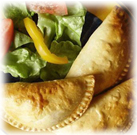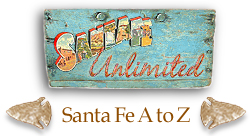|
|||
 "Easy Rider" "Easy Rider"Directed by Dennis Hopper and starring Hopper, Peter Fonda and Jack Nicholson, "Easy Rider" is an American road movie and pastoral. The 1969 film portrays the travels of two bikers from Los Angeles to New Orleans, exploring alternative lifestyles, the American counterculture, and the tensions associated with these lifestyles within mainstream America. The movie was partially filmed in Taos and Las Vegas (New Mexico), with commune scenes set at the New Buffalo Commune in Arroyo Hondo. (~Aimee)  A Bit of "Easy Rider" Movie Trivia: In the Albert Brooks comedy, “Lost In America,” the hapless Brooks compares quitting his job with a major advertising agency to drive across the country in a Winnebago to the characters in "Easy Rider." His wife quietly points out that "those two guys were selling drugs and riding motorcycles." (~Jean) A Bit of "Easy Rider" Movie Trivia: In the Albert Brooks comedy, “Lost In America,” the hapless Brooks compares quitting his job with a major advertising agency to drive across the country in a Winnebago to the characters in "Easy Rider." His wife quietly points out that "those two guys were selling drugs and riding motorcycles." (~Jean)The Eight Northern New Mexico Indian Pueblos The eight pueblos are: Tesuque Pueblo, Pojoaque Pueblo, Nambe Pueblo, San Ildefonso Pueblo, Santa Clara Pueblo, San Juan Pueblo, Picuris Pueblo, and Taos Pueblo. (~Jean) NOTE: See more about the Pueblos in our feature The Pueblos NOTE: See our special feature on Taos Pueblo on Taos Unlimited and in Movie Locations of the Great Southwest El Camino Real A National Historic Trail, El Camino Real is America's oldest and longest continuously used highway. Extending from Mexico City and the port of Veracruz to Santa Fe, New Mexico, and beyond, the over 1,500-mile trail brought European colonists to "New Spain" (New Mexico) 22 years before the Mayflower landed: from 1598 to about 1885. Many of the people now living in the Southwest are decendents of these early settlers. Today, Interstate 25 from Las Cruces to Santa Fe closely parallels the route of El Camino Real through New Mexico. (~Aimee) Empanada  An empanada is a stuffed bread or pastry. The name comes from the Spanish verb “empanar,” meaning to wrap or coat in bread. An empanada is made by folding a dough or bread patty around the stuffing. These delightful treats are either savory or sweet: the first being filled with meat, cheese or spinach; the later with pumpkin, yam, sweet potato, and cream, as well as a wide variety of fruit fillings. (~Jean) An empanada is a stuffed bread or pastry. The name comes from the Spanish verb “empanar,” meaning to wrap or coat in bread. An empanada is made by folding a dough or bread patty around the stuffing. These delightful treats are either savory or sweet: the first being filled with meat, cheese or spinach; the later with pumpkin, yam, sweet potato, and cream, as well as a wide variety of fruit fillings. (~Jean)Enchilada A corn tortilla usually filled with meat or cheese and smothered with a tomato and chili pepper sauce. Shredded cheese is then melted on top. Commonly added toppings and garnishes include sour cream, lettuce, olives, chopped onions, chili peppers, and fresh cilantro. Enchiladas are most often served on a platter with refried beans and Spanish rice. (~Jean) Espanola Valley The sprawling Espanola Valley lies between Santa Fe and Taos. The land is rich and fertile, with the life-giving Rio Grande bisecting the Valley floor on its way to the Gulf of Mexico. The Rio Chama and the Santa Cruz River merge with the Rio Grande near Espanola. Views in the area are breathtaking, from the towering cottonwoods of the river bosque to the majestic Sangre de Cristo range to the east and the Jemez Mountains to the west. Within the Valley is the city of Espanola and several other smaller communities: Chimayo, Alcalde, Velarde, Hernandez, Truchas, Cordova, Dixon, La Puebla, and Arroyo Seco. Three of the Eight Northern New Mexico Pueblos are also located in Espanola Valley: Santa Clara Pueblo, San Ildefonso Pueblo, and Ohkay Owingeh Pueblo (formerly known as the San Juan Pueblo). The picturesque communities of Velarde, Dixon and Embudo are known for their fine vegetables, orchards, wineries, small farms, and cottage industries. As part of the larger Rio Grande rift system, the Espanola Valley is different from most valleys, which are created by the slow and steady stream-cutting action of flowing water. Instead, 30 million years ago, volcanic activity created two parallel fault zones that cut across the region from north to south. When the faults moved, the area between them dropped and formed the Rio Grande Valley. The Rio Grande basin as a whole is the fifth-largest watershed in North America. The city of Espanola and most of the other villages in the region are located next to rivers, where the soils are rich and fertile. In these villages, river water follows the course of acequias (or irrigation ditches) that were laid out by Spanish settlers more than 400 years ago. (~Jean) Pictured top to bottom: 1} A scene from the 1960s cult classic "Easy Rider"; 2} Empanadas |
|||
Home | Food | Lodging | Merchants | Services | Real Estate | Art & Galleries | Entertainment | Recreation Ski Areas | Mind-Body-Spirit | Santa Fe Information | Local Color | Canyon Road | The Turquoise Trail | Santa Fe Plaza The Pueblos | Scenic Beauty | Day Trips | Chili | Special Events | Santa Fe History | Multicultures | Museums High Road to Taos | The Wild West | Churches | Plants & Wildlife | Santa Fe Railyard | Turquoise | Architecture Fiesta | Indian Market | Spanish Market | Zozobra | Features | About Us | Get Listed! | Santa Fe Unlimited Trading Post Photo of the Week | Link of the Month | Testimonials | Santa Fe Webcams | Santa Fe Weather Santa Fe A to Z | Movie Locations | Santa Fe Unlimited Guestbook | Sitemap | Contact Us | Taos Unlimited All original graphics and content of this website, unless otherwise indicated, are copyright © 2006-2011 Santa Fe Unlimited and may not be reproduced in any fashion. |
|||

